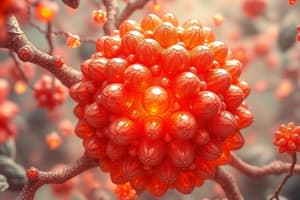Podcast
Questions and Answers
¿Cuál de las siguientes afirmaciones sobre los lípidos dietéticos es correcta?
¿Cuál de las siguientes afirmaciones sobre los lípidos dietéticos es correcta?
- Los ácidos grasos saturados son siempre beneficiosos.
- Las grasas trans están vinculadas a efectos adversos en la salud. (correct)
- Todos los tipos de aceites vegetales son perjudiciales.
- Los lípidos dietéticos no son importantes para la salud.
¿Cuál es el papel principal de la lipogénesis en el organismo?
¿Cuál es el papel principal de la lipogénesis en el organismo?
- Transportar lípidos a través del torrente sanguíneo.
- Sintetizar ácidos grasos a partir de acetil-CoA. (correct)
- Regular los niveles de colesterol en la sangre.
- Descomponer los ácidos grasos para obtener energía.
¿Cuál de los siguientes tipos de ácidos grasos se considera beneficioso para la salud general?
¿Cuál de los siguientes tipos de ácidos grasos se considera beneficioso para la salud general?
- Ácidos grasos saturados
- Ácidos grasos omega-3 (correct)
- Ácidos grasos trans
- Ácidos grasos cis
¿Cuál es la función principal de las lipoproteínas en el organismo?
¿Cuál es la función principal de las lipoproteínas en el organismo?
¿Qué efecto tienen los lípidos en la dieta sobre los niveles de colesterol en sangre?
¿Qué efecto tienen los lípidos en la dieta sobre los niveles de colesterol en sangre?
¿Cuál de los siguientes tipos de lípidos se caracteriza por tener una estructura de cuatro anillos?
¿Cuál de los siguientes tipos de lípidos se caracteriza por tener una estructura de cuatro anillos?
¿Qué tipo de ácido graso contiene más de un enlace doble en su cadena de carbono?
¿Qué tipo de ácido graso contiene más de un enlace doble en su cadena de carbono?
¿Cuál es la principal función de los triglicéridos en los organismos animales?
¿Cuál es la principal función de los triglicéridos en los organismos animales?
¿Cuál de las siguientes afirmaciones sobre los fosfolípidos es correcta?
¿Cuál de las siguientes afirmaciones sobre los fosfolípidos es correcta?
¿Qué proceso es responsable de la descomposición de triglicéridos en ácidos grasos y glicerol?
¿Qué proceso es responsable de la descomposición de triglicéridos en ácidos grasos y glicerol?
¿Cuál de las siguientes funciones biológicas no está asociada a los lípidos?
¿Cuál de las siguientes funciones biológicas no está asociada a los lípidos?
En la dieta, los ácidos grasos trans son generalmente considerados:
En la dieta, los ácidos grasos trans son generalmente considerados:
¿Qué tipo de lípido se utiliza principalmente para la impermeabilización en plantas?
¿Qué tipo de lípido se utiliza principalmente para la impermeabilización en plantas?
Flashcards
Lípidos
Lípidos
Grupo diverso de moléculas hidrofóbicas compuestas principalmente de carbono, hidrógeno y oxígeno.
Ácidos Grasos
Ácidos Grasos
Cadenas largas de átomos de carbono con un grupo carboxilo (-COOH) en un extremo y un grupo metilo (-CH3) en el otro.
Ácidos Grasos Saturados
Ácidos Grasos Saturados
Ácidos grasos con enlaces simples entre los átomos de carbono, formando una cadena lineal.
Ácidos Grasos Insaturados
Ácidos Grasos Insaturados
Signup and view all the flashcards
Triglicéridos
Triglicéridos
Signup and view all the flashcards
Fosfolípidos
Fosfolípidos
Signup and view all the flashcards
Esteroides
Esteroides
Signup and view all the flashcards
Lípidos como fuente de energía
Lípidos como fuente de energía
Signup and view all the flashcards
Lipolisis
Lipolisis
Signup and view all the flashcards
Membranas Celulares
Membranas Celulares
Signup and view all the flashcards
Oxidación de ácidos grasos
Oxidación de ácidos grasos
Signup and view all the flashcards
Lipogénesis
Lipogénesis
Signup and view all the flashcards
Lipoproteínas
Lipoproteínas
Signup and view all the flashcards
Función del hígado en lípidos
Función del hígado en lípidos
Signup and view all the flashcards
Lípidos en la dieta
Lípidos en la dieta
Signup and view all the flashcards
Ácidos grasos saturados
Ácidos grasos saturados
Signup and view all the flashcards
Ácidos grasos insaturados
Ácidos grasos insaturados
Signup and view all the flashcards
Grasas trans
Grasas trans
Signup and view all the flashcards
Ácidos grasos esenciales
Ácidos grasos esenciales
Signup and view all the flashcards
Study Notes
Tipos De Lípidos
- Lipids are a diverse group of hydrophobic molecules, primarily composed of carbon, hydrogen, and oxygen.
- They are categorized based on their structure and function.
- Common types include fatty acids, triglycerides, phospholipids, steroids, and waxes.
- Fatty acids are long hydrocarbon chains with a carboxyl group at one end.
- Triglycerides are the main form of fat storage in animals, composed of glycerol and three fatty acids.
- Phospholipids have a hydrophilic "head" and two hydrophobic "tails," essential for cell membranes.
- Steroids have a characteristic four-ring structure, with cholesterol being a crucial precursor for many steroid hormones.
- Waxes are esters of long-chain fatty acids and alcohols, serving protective functions in plants and animals.
Estructura De Los Ácidos Grasos
- Fatty acids are long chains of carbon atoms.
- They have a carboxyl group (-COOH) at one end and a methyl group (-CH3) at the other.
- The carbon atoms are linked by single (saturated) or double (unsaturated) bonds.
- Saturated fatty acids have only single bonds between carbon atoms, leading to a straight chain.
- Unsaturated fatty acids contain one or more double bonds, causing a bend or "kink" in the chain.
- Monounsaturated fatty acids have one double bond.
- Polyunsaturated fatty acids contain more than one double bond.
- The length of the carbon chain and the degree of saturation affect the physical properties of fatty acids (melting point, fluidity).
Funciones Biológicas de los Lípidos
- Lipids are crucial components of cell membranes. Phospholipids, in particular, form the bilayer structure responsible for cellular compartmentalization.
- Triglycerides serve as a primary energy storage form, providing a highly concentrated source of calories.
- Steroids, like cholesterol, are vital precursors for hormones (e.g., testosterone, estrogen) and bile acids.
- Lipids are essential for insulation and protection of organs.
- Fatty acids are important components of cellular signaling molecules.
- Waxes provide waterproofing and protection.
Metabolismo De Lípidos
- Lipid metabolism encompasses the processes of lipid synthesis, degradation, and transport within the body.
- Lipolysis is the breakdown of triglycerides into fatty acids and glycerol, often triggered by hormonal signals like glucagon.
- Fatty acid oxidation (beta-oxidation) is a crucial metabolic pathway that breaks down fatty acids into acetyl-CoA for energy production via the citric acid cycle.
- Lipogenesis is the synthesis of fatty acids from acetyl-CoA, primarily occurring in the liver.
- Lipids are transported in the blood via lipoproteins, which carry them from their site of origin to their site of use or storage.
- The liver plays a central role in lipid metabolism, regulating the synthesis and secretion of lipoproteins.
Lípidos En La Dieta
- Dietary lipids are essential for proper health.
- Sources include animal fats (butter, meat), vegetable oils (olive oil, corn oil), and some dairy products.
- Saturated fatty acids are often associated with increased risk of heart disease when consumed in excess.
- Unsaturated fatty acids, particularly omega-3 and omega-6 fatty acids, are considered beneficial for overall health.
- The amount and type of dietary lipids can influence blood cholesterol levels and contribute to overall energy balance.
- Trans fats, produced during food processing, are linked to adverse health effects.
- Adequate intake of essential fatty acids that cannot be synthesized by the body is necessary.
Studying That Suits You
Use AI to generate personalized quizzes and flashcards to suit your learning preferences.




